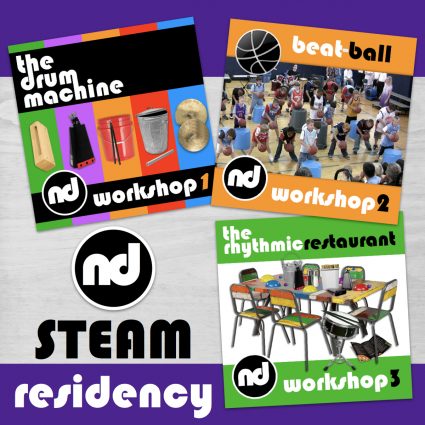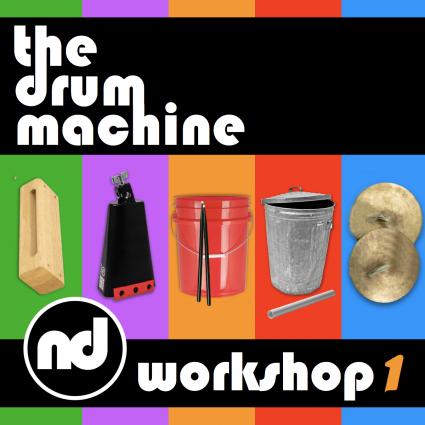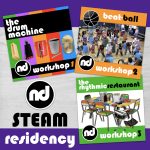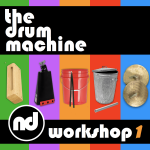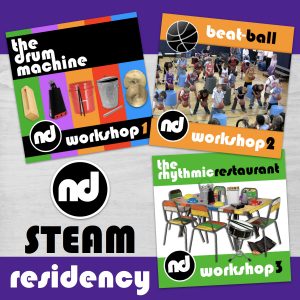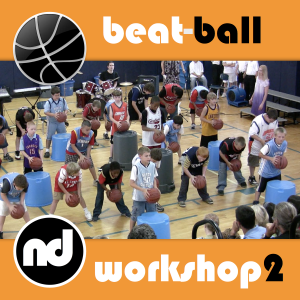Number Drummer
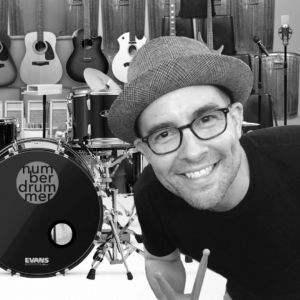
Number Drummer creator, Troy Kryzalka, has worked in music and education for over 20 years. Along with being a musician and classroom teacher, Troy has worked in curriculum and instruction as a trainer, coach, and developer. Number Drummer was created because Troy struggled to learn and understand
…
View moreEducator CONTACT INFO
SELECT A PROGRAM
VIRTUAL Number Drummer STEAM Residency

Program Description
The VIRTUAL Number Drummer STEAM Residency is a series of 3 workshops that provide a sequence of creative and engaging math & music experiences.
Workshop 1
The Drum Machine: Is there a relationship between 2 and 8? What is the connection between division and fractions? What does y=2x sound like? Students experience the relationship of numbers and the connection of different math concepts
Booking / scheduling contact
Program Detail
Based upon availability
Based upon availability
Number Drummer provides every participant with an interactive experience through sound and visuals, and through the kinesthetic and tactile experience of playing an instrument.
VIRTUAL WORKSHOPS | please provide the following…
1) Campus location with access to streaming technology (webcam, audio-source, projector, large screen or display, etc.) Contact artist for further detail.
2) A location that sound volume will not be an issue.
3) Classroom Instrument Kit (Contact artist for options and further details)
ON-CAMPUS WORKSHOPS | please provide the following…
1) 60 minutes of set-up and strike time
2) Large space for social-distancing (Gym preferred). As an extra precaution and out of respect for students and staff, increased social-distancing (>6 ft.) is requested during the visit. Masks are preferred, so please notify the artist of your mask policy.
2) 15 minutes between workshops for sanitizing materials. (School responsible for providing cleaning supplies and assisting in cleaning the materials after each workshop.)
3) Projector and screen (or blank wall)
See Space / Technical Requirements
VIRTUAL: $595; On-Campus: $895; Multi-Residency Discount Available for Virtual or On-Campus bookings (single campus only)
EDUCATION STANDARDS
UPDATED: 2018-19 North Carolina Standard Course of Study for K-8 Mathematics
During Number Drummer Workshops and Live Interactive Performances, participants experience math content from a
variety of standards and at a variety of levels. Listed are the top 6 overall standards followed by a list of specific standards
that students kindergarten through 8th grade rhythmically perform and experience through Number Drummer.
Top 6 Math Standards demonstrated through Number Drummer
CC – Counting & Cardinality
OA – Operations and Algebraic Thinking
MD – Measurement & Data
NF – Number and Operations—Fractions
RP – Ratios and Proportions
EE – Expressions & Equations
List of Grade Level Specific Standards from the NC Standard Course of Study for K-8 Mathematics (2018-19)
Kindergarten
Counting and Cardinality NC.K.CC.1-7
Operations and Algebraic Thinking NC.K.OA.1 (Addition using sound)
1st Grade
Measurement & Data NC.1.MD.5 (Money: The rhythmic sound of pennies, nickels and dimes)
Geometry NC.1.G.3 (Intro to fractions through partitions of a rectangle)
2nd Grade
Measurement & Data NC.2.MD.1 (Length related to beat & rhythm)
Measurement & Data NC.2.MD.8 (Money: The rhythmic sound of pennies, nickels and dimes)
Operations and Algebraic Thinking NC.2.OA.3-4 (Repeated Addition; Rectangular Arrays, Odd & Even)
Geometry NC.2.G.3 (Intro to fractions through rows, columns and partitions)
3rd Grade
Operations and Algebraic Thinking NC.3.OA.1 (Rhythm & Beat through Repeated Addition & Arrays)
Operations and Algebraic Thinking NC.3.OA.2 (Rhythm & Beat through Division & Arrays)
Operations and Algebraic Thinking NC.3.OA.7 (Facts and Relationship between Multiplication & Division)
Operations and Algebraic Thinking NC.3.OA.9 (Patterns in a multiplication table or 100s board)
Number and Operations—Fractions NC.3.NF.1-4 (Fractions, Number Lines, Comparisons, Equivalents)
Measurement & Data NC.3.MD.2 (Beat & Rhythm through customary measurement)
4th Grade
Operations and Algebraic Thinking NC.4.OA.4-5 (Factors, Multiples, Patterns)
Number and Operations—Fractions NC.4.NF.1-3 (Simplify, Compare, Equivalents)
5th Grade
Operations and Algebraic Thinking NC.5.OA.3 (Numerical patterns – Input/Output).
Number and Operations—Fractions NC.5.NF.3 (Reinforce & Extend, Multiply & Divide, Mixed, Improper)
Measurement & Data NC.5.MD.1 (Beat & Rhythm through conversions of customary measurement)
6th Grade
Ratios and Proportional Relationships NC.6.RP.1-3 (Rhythm through ratios; Rhythmic tables that demonstrate ratios)
Number System NC.6.NS.3 (Beat & Rhythm demonstrated through the GCF & LCM)
Expressions & Equations NC.6.EE.9 (Rhythmically represent relationships between dependent and independent variables.)
Reinforcement of prior skills (OA, NF)
7th Grade
Ratios and Proportional Relationships NC.7.RP (Rhythmically represent & perform proportional relationships.)
Reinforcement of prior skills (NF, NS, EE)
8th Grade
Expressions & Equations NC.8.EE.2 (Compare two different proportional relationships as two rhythm patterns.)
Functions NC.8.F.4 (Construct a function to model a linear relationship between two quantities.)
Statistics & Probability NC.8.SP.4 (Rhythmically demonstrate a two-way relative frequency table as a proportional
relationship)
Reinforcement of prior skills (NF, NS, RP, EE)
UPDATED: 2018-19 North Carolina English Language Arts Standard Course of Study (K-5)
Top 3 North Carolina English Language Arts Standards
RF – Reading Foundations: Phonological Awareness
RF – Reading Foundations: Phonics and Word Recognition
L – Language: Vocabulary Acquisition and Use
North Carolina English Language Arts Standard Course of Study (K-5)
RF – Reading Foundations
From kindergarten through 5th grade (and even above), phonological awareness is integrated through being able to demonstrate understanding of spoken words, syllables, and sounds (phonemes) (2). Phonics and word recognition requires students to be able to decode and read accurately unfamiliar multisyllabic words (3). The comparison between syllabication and rhythm is used as an illustrative tool to help students hear what certain fractions sound like and to expedite a student’s ability to learn and perform the music in a short period of time.
North Carolina English Language Arts Standard Course of Study (K-8)
L – Vocabulary Acquisition and Use
From kindergarten through 8th grade, students must be able to determine or clarify the meaning of unknown and multiple-meaning words and phrases based on grade level reading and content area vocabulary. Vocabulary exposure and usage is very important within Number Drummer performances, workshops, and sessions because if provides even greater understanding and connectedness between mathematics and music. It also allows the participants to make classroom and real-world connections after their Number Drummer experience.
NC Essential Standards – SCIENCE
During a Number Drummer Workshop or Live interactive performance, participants experience a strong connection to the following science concepts: Sound, Motion, “Reduce, Reuse, Recycle”, and Genetics. The interdisciplinary connection of Number Drummer to genetics is found in the comparison between mathematical and rhythmic patterns to patterns and probability in genetics. Listed are 4 key concepts followed by an expanded list of specific science essential standards (Kindergarten through 8th grade) experienced through Number Drummer Live interactive performances and workshops.
4 Key Concepts for Science (K-2, 3-5, 6-8)
Physical Science – Matter and physical properties of sound (Vibration, dynamics, pitch, timbre, etc.)
Physical Science – Motion in relation to music (Time & Distance compared to Tempo & Duration)
Life Science – Protecting the environment (Reduce, Reuse, Recycle)
Life Science – Genetics (Rhythmic DNA)
K.P.2 Understand how objects are described based on their physical properties and how they are used.
K.P.2.2 Compare the observable physical properties of different kinds of materials (wood, metal, plastic, etc) from which objects are made and how they are used. (Instrument timbre)
1.L.1 Understand characteristics of various environments and behaviors of humans that enable plants and animals to survive.
1.L.1.3 Summarize ways that humans protect their environment and/or improve conditions (e.g., reuse or recycle products to avoid littering).
2.P.1 Understand the relationship between sound and vibrating objects.
2.P.1.1 Illustrate how sound is produced by vibrating objects and columns of air.
2.P.1.2 Summarize the relationship between sound and objects of the body that vibrate
3.P.1 Understand motion and factors that affect motion.
3.P.1.2 Compare the relative speeds (faster or slower) of objects that travel the same distance in different amounts of time. (TEMPO)
4.P.2 Understand the composition and properties of matter before and after they undergo a change or interaction.
4.P.2.1 Compare the physical properties of samples of matter (strength, hardness, flexibility, and density) ~ Connected to rhythmic instruments and their sound properties
5.L.3 Understand why organisms differ from or are similar to their parents based on the characteristics of the organism. (Genetics)
5.L.3.2 Give examples of likenesses that are inherited and some that are not. (Comparison to why some rhythms sound the same and why their mathematical make-up is the same or similar)
6.P.1 Understand the properties of waves and the wavelike property of energy in earthquakes, light and sound waves.
6.P.1.3 Explain the relationship among the rate of vibration, the medium through which vibrations travel, sound and hearing.
7.P.1 Understand motion, the effects of forces on motion and the graphical representations of motion.
7.P.1.4 Interpret distance versus time graphs for constant speed and variable motion. (TEMPO, BEAT, RHYTHM)
Earth/Environmental Science (EEn.2.8) Evaluate human behaviors in terms of how likely they are to ensure the ability to live sustainably on Earth.
EEn.2.8.4 Evaluate the concept of “reduce, reuse, recycle” in terms of impact on natural resources.
NC Essential Standards – MUSIC
During a Number Drummer Workshop or Live interactive performance, participants experience a spectrum of musical concepts, but the foundation of Number Drummer is built upon the following musical elements: Beat, Rhythm, Timbre, Dynamics, Tempo, and Form. Most importantly is the interdisciplinary element of Number Drummer, which is the connection between math and music. (K-8 CR.1) Listed are the top 3 standards followed by an expanded list of principal music standards that students (Kindergarten through 8th grade) experience through a Number Drummer Live interactive performance or workshop.
Top 3 Essential Standards for Music
ML.1.3 – Execute rhythmic patterns using body, instruments, or voice.
ML.3.2 – Create compositions & arrangements using a variety of traditional & non-traditional sound sources.
CR.1.2 – Understand the relationships between music and concepts from other areas
Grades K-3.ML.1 Apply the elements of music and musical techniques in order to sing and play music with accuracy and expression.
K.ML.1.3
Execute simple rhythms using body, instruments, or voice.
K.ML.1.5
Illustrate a steady beat.
1.ML.1.3
Execute rhythmic patterns using body, instruments, or voice.
2.ML.1.3
Execute extended rhythmic patterns using body, instruments, or voice.
2.ML.1.4
Apply changes in music to the elements of dynamics, tempo, melody, and form.
3.ML.1.3
Use instruments to perform rhythmic and melodic patterns accurately and independently on classroom rhythmic and melodic instruments.
Grades 4-8.ML.3 Create music using a variety of sound and notational sources.
4.ML.3.2
Create compositions and arrangements using a variety of traditional and non-traditional sound sources.
4.ML.3.3
Create rhythmic compositions which include the use of whole, dotted half, half and quarter notes; whole, half and quarter rests; and beamed eighth notes in duple and triple time and which are arranged using a variety of sound sources.
5.ML.3.3
Create rhythmic compositions using notation for whole, dotted half, half, and quarter notes; whole, half and quarter rests; and beamed eighth notes in duple, triple, and common time and which are arranged using a variety of sound sources.
6.ML.3.2
Construct arrangements of simple pieces for voices or instruments other than those for which the pieces were written.
7.ML.3.2
Construct simple examples of musical styles or forms using a variety of traditional and non-traditional sound, notational, and technological sources.
8.ML.3.2
Construct short pieces within specified guidelines (e.g., a particular style, form, instrumentation, compositional technique), using a variety of traditional and non-traditional sound, notational, and 21st century technological sources.
Grades K-8.CR.1 Understand global, interdisciplinary, and 21st century connections with music.
K-8.CR.1.2
Understand the relationships between music and concepts from other areas (Mathematics).
Qualifications
Cancellation Policy
If either party cannot perform this contract due to inclement weather or hazardous conditions, illness or injury, or other cause beyond the control of the parties, then either party reserves the right to reschedule. The customer may cancel the contract before 30 or more days of the scheduled start date, but is required to pay a 30% cancellation fee (This is to prevent people from freezing a date and then simply canceling.) If the customer cancels within 30 days of the scheduled start date, the full contract amount is due. (Most scheduling is done 30 or more days in advance, so service dates cancelled within 30 days would most likely remain unscheduled.) Thank you for your understanding.

